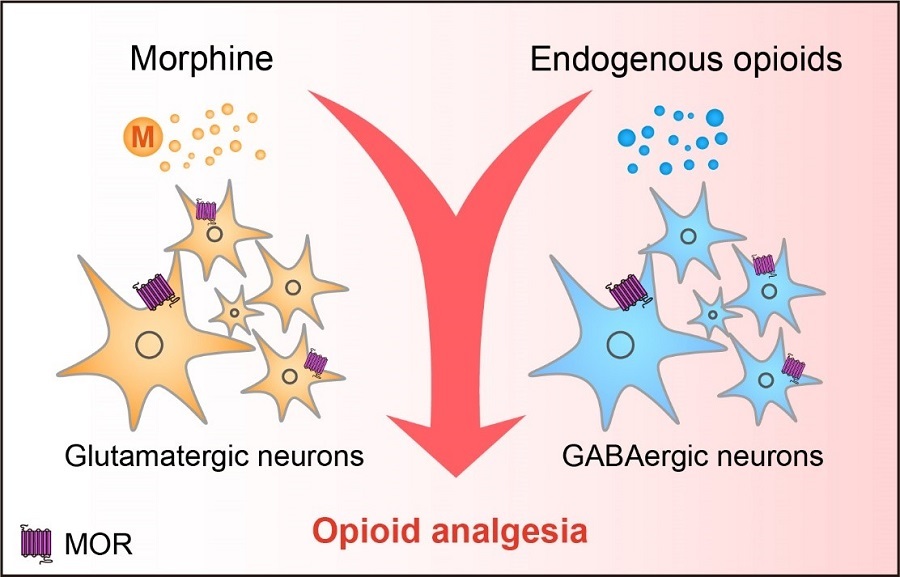Time:2020-06-12
A recent study published in eLife reveals the different neural mechanisms underlying opioid analgesia. This study was performed by researchers in Dr. SUN Yan-Gang’s Lab at the Institute of Neuroscience, State Key Laboratory of Neuroscience, Center for Excellence in Brain Science and Intelligence Technology of the Chinese Academy of Sciences.
Using a combination of genetic, pharmacological, and behavioral approaches, the authors reveal that analgesic effects of exogenous and endogenous opioids on inflammatory pain are mediated by mu opioid receptors (MORs) expressed in glutamatergic and GABAergic neurons, respectively. This study provides new mechanistic insight into the neural mechanisms underlying pain modulation, paving the way for designing new strategy for pain management.
Pain is a complex experience, and serves as an important protective mechanism, which is critical for the survival of animals and humans. However, chronic pain caused by severe injuries or chronic diseases negatively affects the life quality of patients. Persistent or recurrent pain affects more than 20% of the global population.
Therefore, an appropriate and effective analgesic is urgently needed. Opioids have been used in pain relief for thousands of years, and still remain to be the most powerful analgesics used clinically.However, the long-term use of opioids is limited by numerous adverse side-effects. At present, the neural mechanism of opioid analgesia is not fully understood, thus further study of opioid analgesia mechanism could guide clinical opioid drug application and contribute to the development of novel opioid analgesics with less side effects.
Both exogenous and endogenous opioids exert analgesic effects by acting on MORs, which are widely expressed throughout the nervous system. Using a genetic “knockout first, in situ restoration” strategy, researchers investigated the functional role of MORs expressed in different neuronal populations to elucidate the neural mechanism of opioid analgesia.
They found that exogenous opioids (such as morphine) produce analgesic effect by activating MORs in glutamatergic excitatory neurons, whereas the endogenous opioids relieve chronic inflammatory pain by acting on MORs in GABAergic inhibitory neurons. The functional role of MORs expressed at peripheral, spinal, and supraspinal levels for analgesia was further examined. MORs expressed at the spinal level is mainly involved in the analgesic effect of morphine in acute pain, but not in endogenous opioid analgesia during chronic inflammatory pain.
In addition, MORs in the excitatory and inhibitory neurons of the spinal cord play opposite roles in pain modulation. Activation of MORs in excitatory neurons in the spinal cord results in analgesic effects, conversely, activation of MORs in spinal GABAergic neurons induces hyperalgesia. At the supraspinal level, MORs expressed in the parabrachial nucleus are involved in the analgesic effect of morphine on inflammatory pain.
This study, together with the research online published in Neuroscience Bulletin in May 2020 by the SUN lab, reveals the potential role of MORs in different neuronal populations for opioid analgesia and dependence, providing an important basis for further elucidating the mechanism of opioid action.

Figure legend: Schematic showing the mechanisms underlying opioid analgesia. (Image by CEBSIT)
This work entitled “Different neuronal populations mediate inflammatory pain analgesia by exogenous and endogenous opioids” was published online in eLife on June 10, 2020. This work was completed by ZHANG Xinyan and DOU Yannong, under the supervision of Dr. SUN Yangang, with help from YUAN Lei, LI Qing, ZHU Yanjing and WANG Meng. This work was supported by the National Natural Science Foundation of China, Shanghai Municipal Government, and Chinese Academy of Sciences.
AUTHOR CONTACT:
SUN Yangang
Center for Excellence in Brain Science and Intelligence Technology of the Chinese Academy of Sciences, Shanghai, China.
E-mail: yangang.sun@ion.ac.cn
 附件下载:
附件下载: